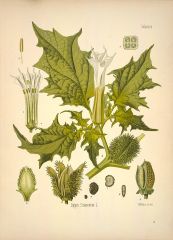Datura: Angel's Trumpet
or Devil's Apple?
By Audrey Stallsmith

But whom do you blame for the will in you
That feeds itself and makes you dock-weed
Jimpson, dandelion or mullen
And which can never use any soil or air
So as to make you jessamine or wisteria?
Edgar Lee Masters, "Calvin Campbell"
Masters would probably be surprised to learn that the once lowly "Jimpson" (or Jimsonweed) has been transformed into a garden flower as exotic and sweet-scented as jessamine and wisteria. Datura and its twin, brugmansia, were all the rage on garden forums a couple years back. Fads don't last long, however, and the current big thing seems to be unusual morning glories.
Still, datura boasts some of the largest and showiest blooms available on an easy-to-grow annual. Those trumpet-shaped flowers open in the evening to attract moths, and usually remain fresh into the following morning--until the day heats up. I've grown several varieties, and think the prettiest is the double purple, sometimes known as 'Blackcurrant Swirl.' Datura discolor, a single white type with a purple center, is also striking.
The recent popularity of the daturas has sparked a running debate about the differences between them and the brugmansias. If what I've learned is correct, daturas are all annuals or short-lived perennials with no woody growth. Their round, spiny seedpods burst open when ripe, and their blooms face upwards.
Brugmansias, on the other hand, grow into woody perennial shrubs or trees in tropical climes. Their blooms dangle downwards, and their longer, narrower, smooth seedpods must be broken open. The "brugs" may all be descendants of the South American tree datura known as arborea.
Daturas tend to have white, purple, or yellow flowers. The brugmansias steer clear of purple, but also run to several shades of orange and pink--even two reds (sanguinea and one of the suaveolens). Although rumors persist that there was once a red datura, it is possible that the plant indicated was really a brug.
Daturas and brugmansias seem to be similar in all other aspects. Both contain the same poisons as belladonna, another member of the solanum family. Those toxins include hyoscyamine, scopolamine (the so-called "truth serum"), and atropine.
The name derives from the Hindu "Dhatura," which was applied to the native type in India--fastuosa, AKA tatorea. Although most other daturas seem to have originated in the Americas, stramonium (the infamous Jimsonweed) is also native to parts of Europe and ferox to China. Stramonium combines the Greek strychnos ("nightshade") and manikos ("mad"). Other nicknames for datura include thorn-apple, devil's apple, devil's trumpet, angel's trumpet, stinkweed, green dragon, apple of Peru, and toloache (the latter probably referring only to Datura innoxia).
The nickname Jimsonweed is supposed to be a corruption of Jamestown weed. Some British soldiers, sent to crush the 1676 Bacon rebellion in the colony, consumed the plant and "turned natural fools upon it." Sources differ as to whether they ate datura as a cooked green, as a spice, or ground the seeds into flour. But the fact that their ill-advised meal turned the men into gibbering idiots for eleven days testifies to the potency of the poison.
At least, the soldiers seem to have consumed the plant out of ignorance. Throughout history, other imprudent persons have taken it deliberately. Datura was frequently used by pagan priests to induce visions. (Frankly, I would have doubts about any god who requires mind-altering chemicals to guide his people!)
Thorn-apple is also reportedly one of the drugs that gave hallucinating witches the impression they could fly. The Thugs of India drugged their victims with datura fastuosa, and new mothers there poisoned unwanted female babies with it. (You can see why "devil" frequently appears in the plant's nicknames.) The whirling dervishes also "fueled" themselves with the plant.
Although sufferers of spasmodic conditions such as asthma and whooping cough once smoked datura to relieve their symptoms, that risky use was banned in the sixties. The plant was also sometimes an ingredient in narcotic ointments for inflammations such as rheumatism, neuralgia, abscesses,and burns.
I am alarmed to note--from a recent episode of C.S.I. and from several web sites I've come across--that datura is regaining popularity as a recreational drug. Since this is one extremely toxic plant, I have to conclude that those rash enough to consume it must be out of their minds---even before they take it! They certainly will be after. If I am remembering correctly, the young user in the TV show went temporarily insane and killed his best friend. That was fiction, but I'm very much afraid that it could easily become fact.
Datura's combination of beauty and danger caused it to stand for "deceitful charms" in the Language of Flowers. But, as I have frequently pointed out in my articles, plants are not responsible for the foolishness of some humans. Just as the devil was once an angel, all evil is a perversion of something good. Whether datura will be angel or devil to you depends on whether you crave its beauty or its bane.
Datura stramonium image is from Kohler's Medizinal-Pflanzen, courtesy of the Missouri Botanical Garden.








